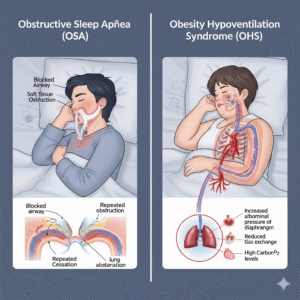OSA vs OHS Breathing disorders during sleep are more common than most people realize. Two often-confused conditions are OSA (Obstructive Sleep Apnea) and OHS (Obesity Hypoventilation Syndrome).
At first glance, these conditions may seem similar—both involve disrupted breathing and both are linked to obesity. However, there are important differences between OSA and OHS in terms of causes, symptoms, diagnosis, and treatment.
In this blog, we’ll compare OSA vs OHS to help you understand how they differ and why getting the right diagnosis matters.

What is OSA (Obstructive Sleep Apnea)?
OSA is a sleep-related breathing disorder where the throat muscles collapse during sleep, blocking airflow.
Key Features of OSA:
-
Repeated pauses in breathing during sleep
-
Loud snoring, gasping, or choking
-
Daytime sleepiness and fatigue
-
Strongly linked with obesity but can also occur in non-obese patients
Main Treatment:
-
CPAP therapy is the gold standard for keeping airways open.
-
Lifestyle changes, oral appliances, or surgery may also help.
What is OHS (Obesity Hypoventilation Syndrome)?
OHS is a more complex condition. It occurs in obese individuals when the body doesn’t get rid of enough carbon dioxide during the day and night, leading to chronic hypoventilation.
Key Features of OHS:
-
Hypoventilation (shallow or reduced breathing)
-
High levels of carbon dioxide in the blood (hypercapnia)
-
Daytime sleepiness, morning headaches
-
Almost always associated with obesity
Main Treatment:
-
Weight management programs
-
Oxygen therapy in severe cases
OSA vs OHS: Key Differences
| Feature | OSA (Obstructive Sleep Apnea) | OHS (Obesity Hypoventilation Syndrome) |
|---|---|---|
| Cause | Throat muscles collapse during sleep | Obesity causes chronic underventilation |
| Main Symptom | Pauses in breathing, loud snoring | High CO₂ levels, low oxygen, sleepiness |
| Obesity Link | Common but not always present | Always linked to obesity |
| Diagnosis | Sleep study (polysomnography) | Blood gas tests + sleep study |
| Treatment | CPAP, lifestyle changes | CPAP/BiPAP, weight loss, sometimes oxygen |
Can OSA and OHS Occur Together?
Yes. Many patients with OHS also have OSA, making diagnosis and treatment more challenging. That’s why thorough testing (sleep study + blood tests) is critical.
Treatment Pathways for OSA vs OHS
-
OSA Treatment:
-
CPAP therapy
-
Oral appliances
-
Lifestyle changes
-
-
OHS Treatment:
-
CPAP or BiPAP therapy
-
Strict weight management
-
Supplemental oxygen (in advanced cases)
-
FAQs
Q1. What are the main differences between OSA and OHS?
OSA is caused by airway obstruction during sleep, while OHS is due to obesity-related hypoventilation.
Q2. Can you have both OSA and OHS?
Yes. Many patients with OHS also have OSA, requiring combined treatment.
Q3. How is OHS diagnosed compared to OSA?
OSA is diagnosed with a sleep study. OHS requires both a sleep study and blood gas analysis to check CO₂ levels.
Q4. Do OSA and OHS require the same treatment?
Both often need CPAP or BiPAP therapy, but OHS also requires weight loss and sometimes oxygen therapy.
Q5. Which is more severe: OSA or OHS?
OHS is considered more serious because it affects breathing both day and night, not just during sleep.
